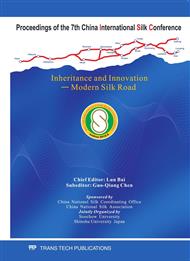p.149
p.153
p.158
p.164
p.170
p.176
p.181
p.186
p.192
EDC-Crosslinked Electrospun Silk-Fibroin Fiber Mats
Abstract:
Electrospun Silk-Fibroin (SF) mats were fabricated by electrospinning with regenerated Bombyx mori silk-fibroin/formic acid solutions. After spinning, the water soluble and mechanical properties of pure fibroin nanofibers were poor. So electrospun SF mats were crosslinked with N-(3-dimethylaminopropyl)-N′-ethylcarbodiimide hydrochloride (EDC), a low cell cytotoxicity crosslinking agent, and N-hydroxysuccinimide (NHS), which can increase the reaction rate. The scanning electron microscope images indicated that the diameter of fibers increased with crosslinking reaction. When EDC/NHS reached to 7.5wt.%, the diameter of fibers achieved the maximum. The mechanical test showed that tensile strength enhanced after crosslinking with EDC/ NHS. While EDC/NHS reached to 7.5wt %, the rupture strength reached to (38.31±5.30) Mpa, and the breaking elongation ratio reached to (182.00±31.27) %. FTIR results showed the the proportion of β-sheet increased while random coil and α-helix decreased after treatment.
Info:
Periodical:
Pages:
170-175
Citation:
Online since:
January 2011
Authors:
Price:
Сopyright:
© 2011 Trans Tech Publications Ltd. All Rights Reserved
Share:
Citation:


